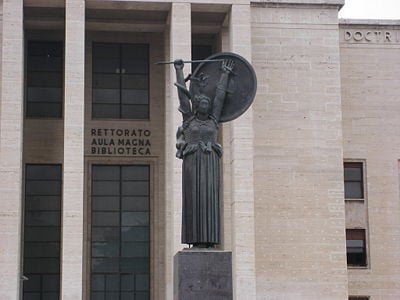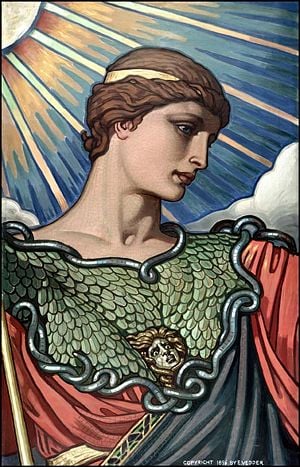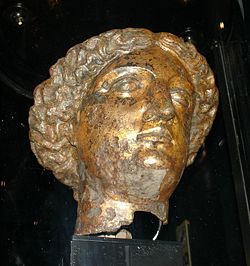Minerva
Minerva was a Roman goddess of crafts, poetry and wisdom, and is known as the inventor of music.
Minerva was the daughter of Jupiter. She was considered to be the virgin goddess of warriors, poetry, medicine, wisdom, commerce, crafts, and the inventor of music. As Minerva Medica, she was the goddess of medicine and doctors.
History
(Please add a history section)
The name "Minerva" is likely imported from the Etruscans who called her Menrva. The Romans would have easily confused her foreign name with their word mens meaning "mind" since one of her aspects as goddess pertained not only to war but also to the intellectual.
Adapting Greek myths about Athena, Romans said that Minerva was not born in the usual way, but rather Jupiter had a horrible headache and Vulcan opened up his head and out came Minerva, fully grown, and dressed in armor, a long trailing robe, a helmet, a shield and a spear.
Worship
Ovid called her the "goddess of a thousand works."[citation needed] Minerva was worshipped throughout Italy, though only in Rome did she take on a warlike character. Her worship was also taken out to the empire - in Britain, for example, she was conflated with the wisdom goddess Sulis.
The Romans celebrated her festival from March 19 to March 23 during the day which is called, in the feminine plural, Quinquatria, the fifth after the Ides of March, the nineteenth, the artisans' holiday. A lesser version, the Minusculae Quinquatria, was held on the Ides of June, June 13, by the flute-players, who were particularly useful to religion. In 207 B.C.E., a guild of poets and actors was formed to meet and make votive offerings at the temple of Minerva on the Aventine hill. Among others, its members included Livius Andronicus. The Aventine sanctuary of Minerva continued to be an important center of the arts for much of the middle Roman Republic.
Minerva was also worshipped on the Capitoline Hill as one of the Capitoline Triad along with Jupiter and Juno, at the Temple of Minerva Medica, and at the "Delubrum Minervae" a temple founded around 50 B.C.E. by Pompey on the site of the church of Santa Maria sopra Minerva (near the present-day Piazza della Minerva and the Pantheon).
Temples
Several famous temples dedicated to the goddess Minerva once existed in the ancient world, especially in Rome.
The temple of Minerva Medica (akin to the temple of Apollo Medicus) was a Roman temple built on the Esquiline Hill in the republican era (cf. Cic. de div. II.123: sine medico medicinam dabit Minerva, and CIL VI.10133, 30980), though no remains of it have been found. It has since the 17th century been wrongly identified with the ruins of a nymphaeum on a nearby site (see picture inset), on account of the erroneous impression that the Athena Giustiniani had been found in its ruins (HJ 360; LS III.158‑161).
The site of another ancient Minerva Temple in Rome is now today a famous Christian church. The Santa Maria sopra Minerva is a basilica church in Rome, which gets its name because, like many early Christian basilicas, it was built directly over (sopra) the foundations of a temple dedicated to the goddess Minerva. Details of the ruined temple to Minerva, built by Pompey about 50 B.C.E., referred to as Delubrum Minervae are not known.
In Assisi, another church of Santa Maria sopra Minerva was built in the 16th century within the surviving cella of a late Republican temple of Minerva. Its Corinthian portico still stands.
In later culture
Universities and educational establishments

As patron goddess of wisdom, Minerva frequently features in statuary, an image on seals, and in other forms, at educational establishments, including:
- A statue of Minerva is located in the center of La Sapienza University, the most important university of Rome.
- Minerva is displayed in front of Columbia University's Low Library as "Alma Mater."
- Minerva is the name of a female residence at the University of Stellenbosch in South Africa.
- Minerva is the name of the computer science server used by students at the Harvard Extension School.
- Minerva is displayed to the East of University of North Carolina at Greensboro's Elliot University Center as a statue.
- Minerva is featured on the seals and logos of many institutions of higher learning:
- University of Lincoln. Minerva's head is used as the logo of this UK University. There is a tradition within the Lincoln rugby team and it is thought they are the Knights of Minerva, each match being won in her honour.
- University at Albany, The State University of New York. Minerva is still venerated by seniors and their 'torch bearers' during a pre-graduation ritual called "Torch Night" there.
- the University of Alabama
- Union College, New York. Union College has also used Minerva as the name of their new academic and social "Third Space" program, the Minerva House System; and, also here, Minerva is the goddess of Theta Delta Chi.
- UFRJ, the Federal University of Rio de Janeiro, in Brazil.
- Ghent University, in Belgium
- American Academy of Arts & Sciences, in Cambridge, Mass. The seal's principal figure is Minerva - a symbol appropriate for an organization created in the midst of the American Revolution and dedicated to the cultivation of every art and science to "advance the interest, honour, dignity, and happiness of a free, independent, and virtuous people."
- Minerva is also the name of the second oldest elite student-association in the Netherlands (Leiden University).
- Minerva decorates the keystone over the main entrance to the Boston Public Library beneath the words, "Free to all." BPL was the original public-financed library in America and, with all other libraries, is the long-term memory of the human race.
- Minerva is the Goddess of the Sigma Alpha Epsilon Fraternity. Fraternity Brothers are known as Loyal Sons of Minerva.
- Minerva is the name of a remote learning facility at Bath Spa University in England, UK.
- Minerva is featured on the seal of the University of Science and Arts of Oklahoma.
Societies
- In the early 20th century, Manuel José Estrada Cabrera, President of Guatemala, tried to promote a "Cult of Minerva" in his country; this left little legacy other than a few interesting Hellenic style "Temples" in parks around Guatemala.
- According to John Robison's Proofs of a Conspiracy (1798), the third degree of the Bavarian Illuminati was called Minerval or Brother of Minerva, in honor of the goddess of learning. Later, this title was adopted for the first degree of Aleister Crowley's OTO rituals.
- Minerva is the logo of the world famous German "Max Planck Society for the Advancement of Science" (Max-Planck-Gesellschaft)
ReferencesISBN links support NWE through referral fees
External Links
Credits
New World Encyclopedia writers and editors rewrote and completed the Wikipedia article in accordance with New World Encyclopedia standards. This article abides by terms of the Creative Commons CC-by-sa 3.0 License (CC-by-sa), which may be used and disseminated with proper attribution. Credit is due under the terms of this license that can reference both the New World Encyclopedia contributors and the selfless volunteer contributors of the Wikimedia Foundation. To cite this article click here for a list of acceptable citing formats.The history of earlier contributions by wikipedians is accessible to researchers here:
- Minerva history
- Santa_Maria_sopra_Minerva history
- Temple_of_Minerva_Medica history
- Temple_of_Minerva_Medica_(temple) history
The history of this article since it was imported to New World Encyclopedia:
Note: Some restrictions may apply to use of individual images which are separately licensed.


